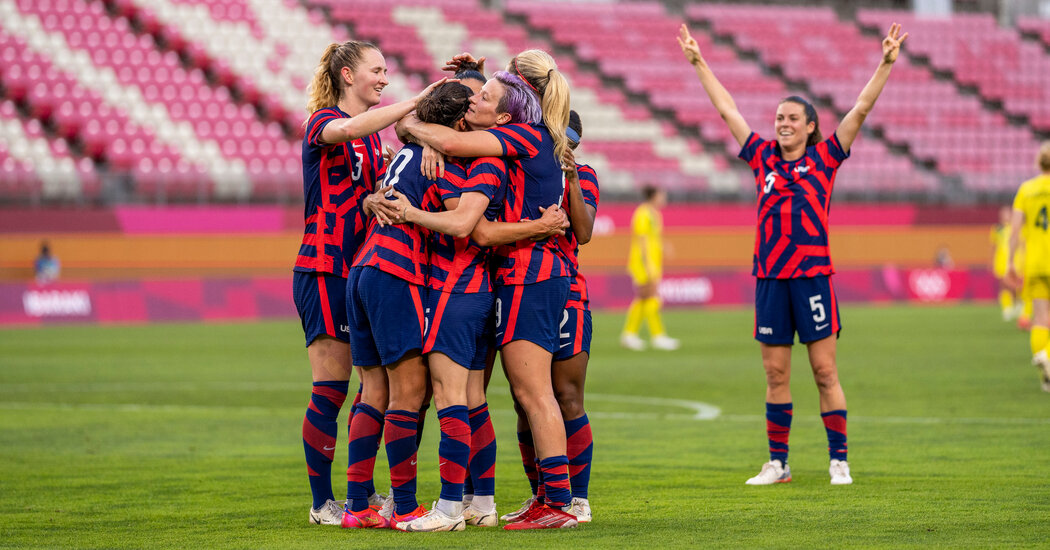
For the first time, soccer players representing the United States men’s and women’s national teams will receive the same pay and prize money, including at World Cups, under landmark agreements with the U.S. Soccer Federation that will end years of litigation and bitter public disputes over what constitutes “equal pay.”
The revised pay structures are part of collective bargaining agreements with each team announced Wednesday, three months after a group of top women’s team players settled a gender discrimination lawsuit against U.S. Soccer and six months before the men’s team is scheduled to take the field at the World Cup in Qatar.
In addition to guaranteeing men’s and women’s players the same paychecks for taking part in international matches, the deals include a provision, believed to be the first of its kind, through which the teams will pool the unequal payments they receive from FIFA, world soccer’s governing body, for participating in the World Cup. Starting with the 2022 men’s tournament and the 2023 Women’s World Cup, that money will be shared equally among the members of both teams.
“No other country has ever done this,” U.S. Soccer President Cindy Parlow Cone said of the deal to equalize World Cup payments. “I think everyone should be really proud of what we’ve accomplished here. It really, truly is historic.”
The split of prize money is a notable concession by the American men, who have previously been awarded the bulk of the multimillion-dollar payments U.S. Soccer receives from FIFA each time the team has played in the World Cup. The agreement to pool the money with the women also removed what players and federation officials had long agreed was the single biggest obstacle to a resolution of the equal pay debate. It represents a potentially huge windfall for the women’s team, whose World Cup prize pool is a fraction of that paid to men’s teams every four years.
Under the new deals, which run through 2028 and cover the next four World Cups, dozens of top men’s and women’s players have been told in internal presentations reviewed by The New York Times that they can expect to collect average annual payouts of about $450,000 from U.S. Soccer — and potentially more than double that in successful World Cup years.
The difference in compensation for men and women has been one of the most contentious issues in soccer in recent years, particularly after the American women won consecutive World Cup championships, in 2015 and 2019, and the men failed to qualify for the 2018 tournament. Over the years, the women’s team, which includes some of the world’s most recognizable athletes, had escalated and amplified its fight in court filings, news media interviews and on their sport’s grandest stages.
The dispute had always been a complex issue, with differing contracts, unequal prize money and other financial quirks muddying the distinctions in pay between the men’s and women’s teams and complicating the ability of national governing bodies like U.S. Soccer to resolve the differences.
Read More on the World Cup
Yet the federation ultimately committed to a fairer system. To achieve it, U.S. Soccer will distribute millions of extra dollars to its best players through a complicated calculus of increased match bonuses, pooled prize money and new revenue-sharing agreements that will give each team a slice of the tens of millions of dollars in commercial revenues that U.S. Soccer receives each year from sponsors, broadcasters and other partners.
Labor peace will be expensive: U.S. Soccer has committed to single-game payments for most matches of $18,000 per player for games won, and as much as $24,000 per game for wins at certain major tournaments — cementing the status of the U.S. men and women as two of the highest-paid national teams in the world. And the federation will surrender as much as 90 percent of the money it receives from FIFA for competing in the World Cup to the men’s and women’s players on those teams; based on past performances and union projections, that could result in a shared prize pool of more than $20 million as soon as next year.
But despite its cost, the new equal pay policy has incalculable value for all involved, as it will end a six-year battle that battered the federation’s reputation; threatened U.S. Soccer’s relationships with important sponsors; and ran up millions of dollars in legal fees on every side of the fight.
As the sides battled in courtrooms and negotiating sessions, the dispute also produced sometimes caustic exchanges about personal privacy, workplace equality and basic fairness, and drew support (and second-guessing) from a disparate chorus of presidential candidates, star athletes and Hollywood celebrities — not all of them supportive of the women’s campaign for pay equity.
Resolving the fight amicably, rather than in court, could make it easier for the federation to attract new sponsors and rebuild bonds with its most prominent players. And by offering the teams a share of its commercial revenues, U.S. Soccer has essentially incentivized its biggest stars to act as partners in finding new ways to increase those revenue streams.
“There’s no denying that money that we have to pay our national teams is money that’s not reinvested in the game,” Cone said when asked about the effects of the new contracts on U.S. Soccer’s broader mission. “And people can take that perspective. But the way I look at it is that our job is to try to figure out how all three groups can work together to grow the pie so that everyone is benefiting.”
Cone and representatives of both teams said the agreements offered a model for those looking to restructure a multibillion-dollar sports industry in which generational advantages mean money, exposure and opportunities still flow disproportionately to men’s sports and male athletes.
“These agreements have changed the game forever here in the U.S.,” Cone said. “And they have the potential to change the game around the world.”
Yet while resolving the equal pay fight will have tremendous symbolic and financial value in the United States, it is unclear if the new deals will be more aspirational than replicable globally.
Since the American women began pressing their equal pay fight in 2016, soccer federations from Norway to Australia to the Netherlands have moved to pay their national teams more equally. But all of those deals sought to equalize matchday pay rates that are far lower than the figures U.S. Soccer pays to its senior teams. And all of them sidestepped the biggest pay gap in soccer: the huge difference in World Cup bonuses paid to men and women by FIFA. The 24 teams at the 2019 Women’s World Cup in France, for example, competed for a prize pool of $30 million; the 32 men’s teams that will compete in Qatar in November will split $450 million.
A negotiated settlement became the only route to equal pay in 2020 after a federal judge dismissed the core claims of a group of top women’s players who had sued the federation for gender discrimination. Cone, a former women’s national team player recently elevated to the role of U.S. Soccer’s volunteer president, greeted that decision with an olive branch at the time, pressing for renewed settlement talks. But she increased the pressure on the men’s players to help bridge that gap last fall when she said U.S. Soccer would not agree to new contracts with either team that did not equalize World Cup prize money.
Walker Zimmerman, a defender on the men’s team and a leader in its players’ union, said he and his teammates had by then come to the realization that “there was no other way to get this done.” Persuading his teammates to ratify the deals that were eventually reached “wasn’t always the smoothest,” he admitted.
“Trying to voice what you believe should happen, what is possible, what is right — those conversations are difficult,” Zimmerman said. “But at the end you have a group of players both on the men’s and women’s side who came together and got it done.”
Despite Wednesday’s spirit of détente, the payments to the U.S. men and women will still not be entirely equal: Injuries, coaching decisions and even the number of games played by each team will continue to affect what individual players can earn. But for the first time, both the teams and the federation will be able to agree that the rate of pay, at least, will be equal.
“We do still have two separate contracts,” Cone said, “but everything economically is exactly the same.”




